"A city built from memory" is a project developed by Nicolas Maurice as part of a Master degree in Visual Communication at Konstfack, University of Arts, Craft and Design in Stockholm, 2016.
It is a reflexion on memory, virtuality, relationality and the construction of identity. It is the building of a three dimensional map of the neighborhood I grew up in, as I remember it. Departing from my writing practice, I place memories in space and let them shape its structure. It is also an experiment in using computer graphics tools and 3D software as a raw material, entering a dialogue with its digital nature, constraints, limitations and possibilities.
The result of this process is a virtual space the spectator is invited to explore through an installation. As one walks in the digital streets, the personal stories of the author unfold within short texts and the structure of the world itself. A book gathering writings and images accompanies the piece, materializing one possible exploration and inviting the reader to make their own.
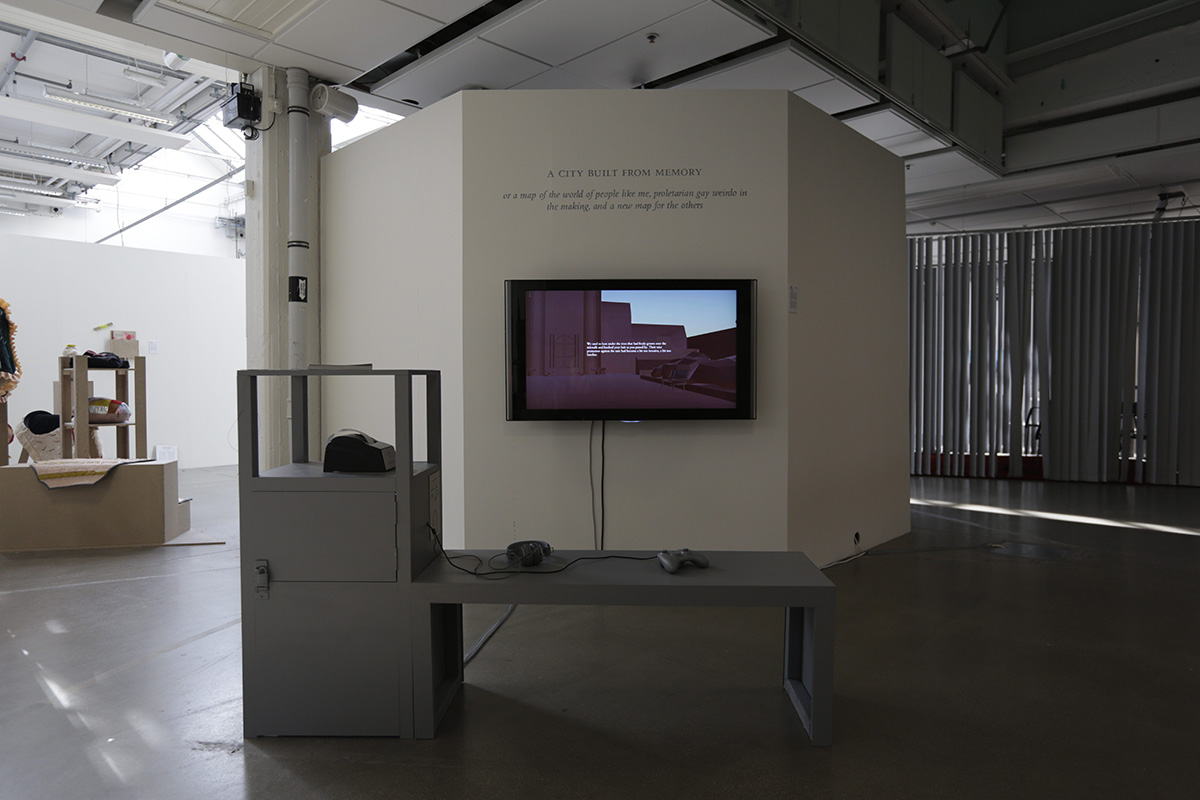
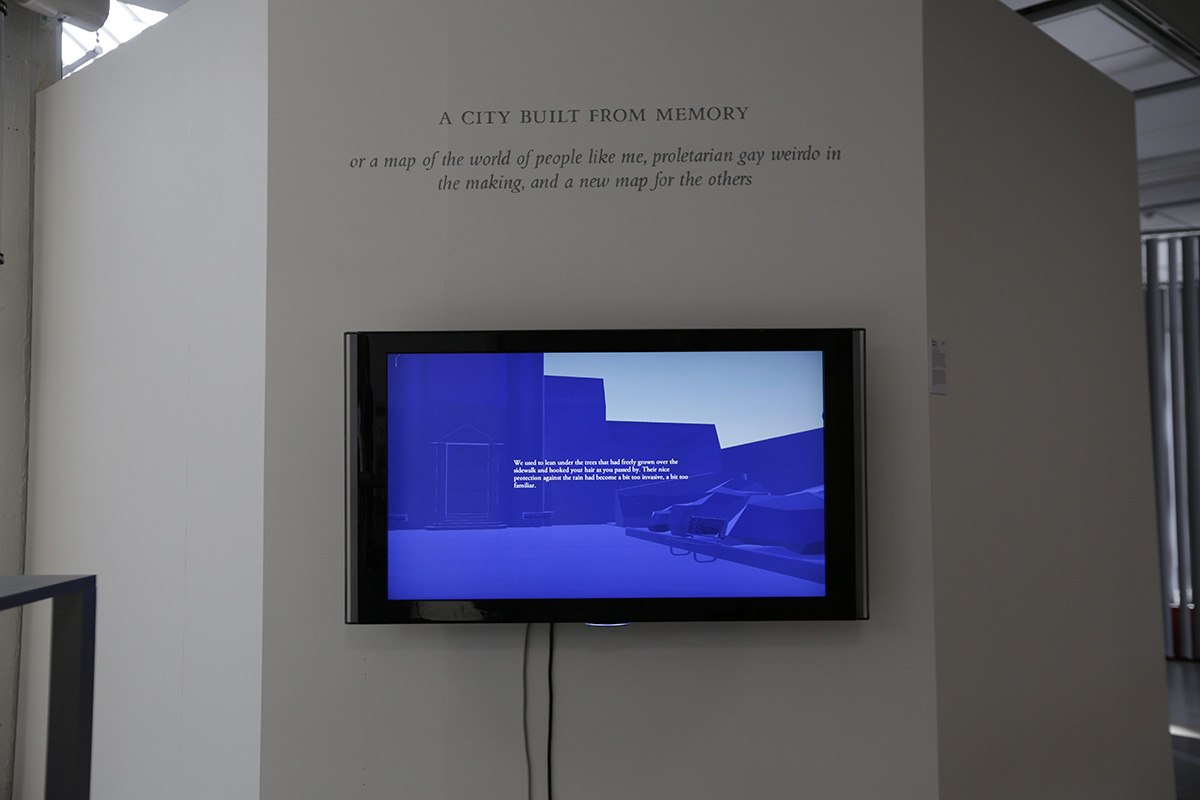
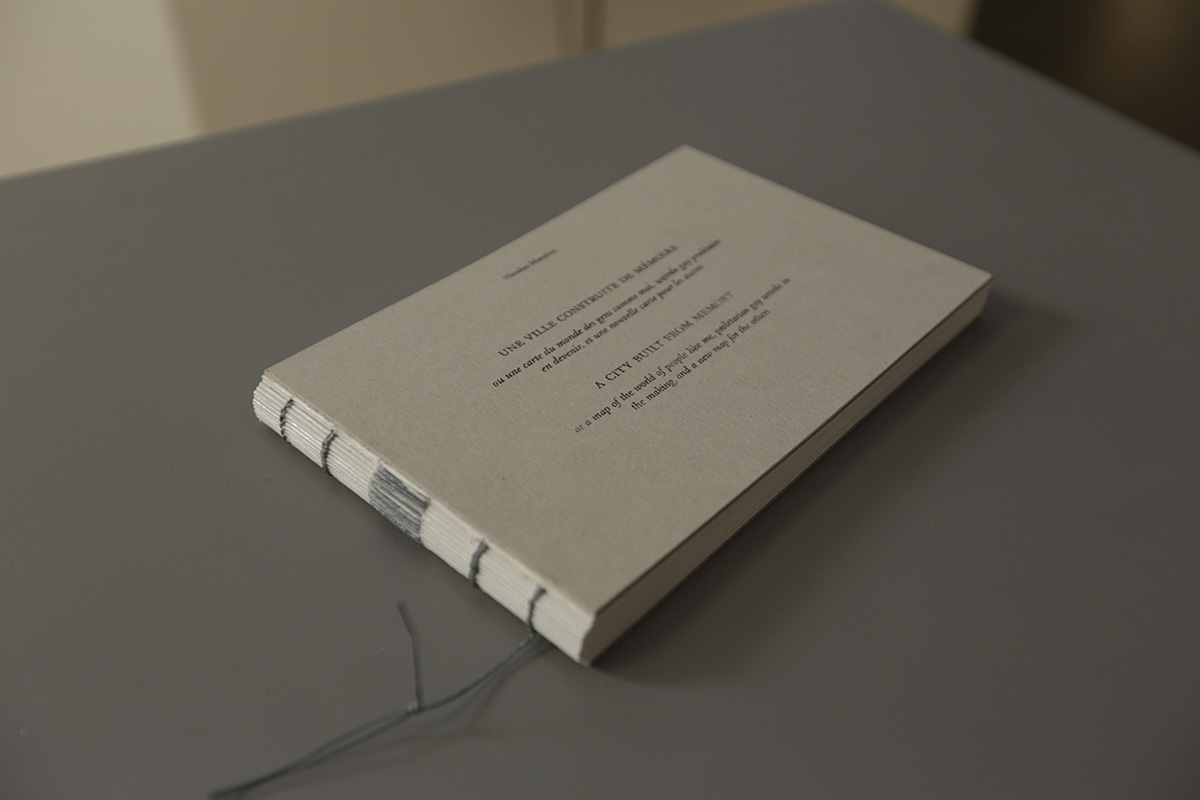

introduction
My name is Nicolas Maurice, I am born and raised in Dunkirk, a small city in the north of France. I studied digital directing for four years and moved to Stockholm in 2008.
My artistic work aims to explore how we live and survive, the illusions we hold on to, the lies we say, the dreams we give up. Striving to stay aware of my own context and agency, my work investigates a deeply concrete experience of interrelationship in a digitalizing era. It is the love for a tragic world in its inhabited decay, a refusal to escape the present, infused with the literature of misfits. It is a possible survival in the shape of writings, images, digital experiments and movies.
The first practice I could call my own started when I began looking at my surroundings through the lens of my camera. I was taking photographs of buildings, industries, parking lots... I was feeling somehow close to Stephen Shore, William Eggleston... I wanted to share the beauty I found in those spaces which people around me seemed to overlook. My studies in movie making triggered an interest in me for the way stories can be told. A delicate narrative craft I would work with through my freelance work as a 3D and stop-motion animator, mainly on animated documentaries. Then another project lead me to writing, about me and about memories.
I started thinking about a personal project, something only I could make, that would combine each of my skills and interests. This is how this project started. I wanted to build the neighborhood I grew up in from memory, in the shape of a virtual world one could explore. My time at Konstfack gave me the space and time to expand and define this rough idea and to materialize it in an installation piece, as we’ll see.
The first question I had to answer for myself, concerned the very nature of my project. How is memory formed? Can I visualize its mechanics? But also, what is this world I want to build? Is it virtual reality? Both the form and content seemed elusive and difficult to describe. I turned to philosophy and linguistics to find some answers. By working with memory, I had the ambition to somehow reach a degree of universality through my most personal experiences. I wanted to share and connect with others. This lead me to consider this process in terms of auto-ethnography, performativity, relationality and in terms of mapping. Interactivity and storytelling are difficult subjects which I had to consider with care and, again, a methodological approach. I turned to Jacques Rancière in this process and made decisions accordingly, aiming for an equal and emancipated relationship between me as the author and the potential spectator. I then had to consider the medium I chose to work with. 3D graphics have a short but dense history, from films and video-games to more experimental art forms. Aware of this context, I set my own rules and method for what I consider my craft.
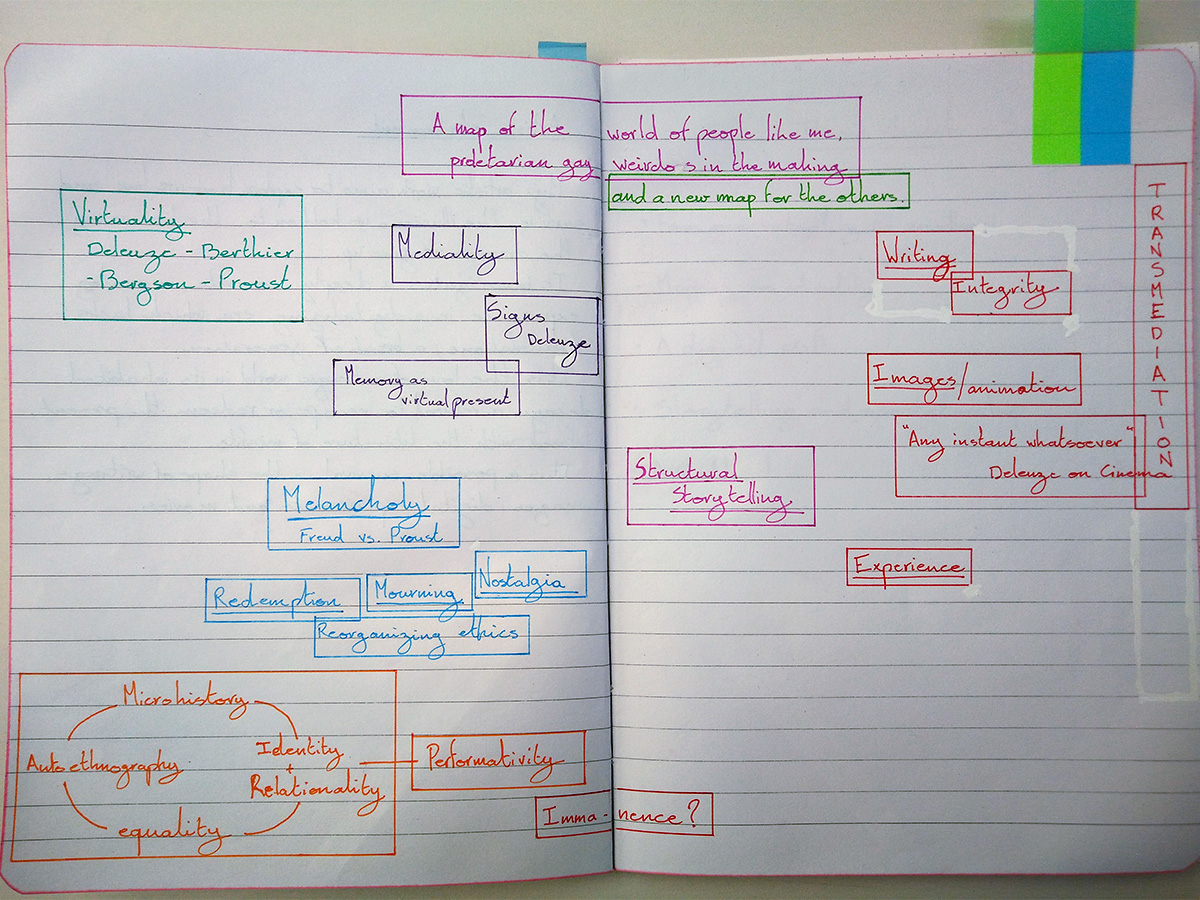
theory and background
i. from one virtuality to another
My theoretical journey started by searching for a conceptual base to think memory, as it was to be my material. For this, I turned to St. Augustine’s “Confessions”, which had made a lasting impression on me after reading and translating parts of the text in high school. Among Augustine’s considerations on remembrance and omission, I would like to extract this quote on the nature of time.
Perhaps it might be said rightly that there are three times: a time present of things past; a time present of things present; and a time present of things future. For these three do coexist somehow in the soul, for otherwise I could not see them. The time present of things past is memory; the time present of things present is direct experience; the time present of things future is expectation.
St. Augustine [1], Book 11, Chapter 20, Heading 26.
The present time of things past... This formulation seemed to me as an antidote to nostalgia, re-centering time around an active subject.
The concept of memory being intrinsically linked to the perception of time, I decided to continue on to Bergson and his work on time, movement and duration. “Time and Free Will: An Essay on the Immediate Data of Consciousness” and “Matter and Memory” seemed to contain elements which could guide me although locked behind a language and complexity out of my reach at the time.
From Bergson to Deleuze and others, looking for something to feed this lingering need for a deeper understanding. I found many related thoughts in these works but I was still seeking the common thread in them that my own work was trying to cling on to. I was starting to read Proust when my meanderings lead me to consider the concept of “virtuality”.
But let a sound, a scent already heard and breathed in the past be heard and breathed anew, simultaneously in the present and in the past, real without being actual, ideal without being abstract, then instantly the permanent and characteristic essence hidden in things is freed and our true being which has for long seemed dead but was not so in other ways awakes and revives, thanks to this celestial nourishment.
Marcel Proust, Time regained, Chapter 3.
“real without being actual, ideal without being abstract”. This definition of memory by Proust is the point of departure for both Bergson and Deleuze in building their definition of virtuality. There was the pivot point of my theoretical work on this piece. Going further than Augustine, Deleuze was defining memory as the past in pure state, the virtual present. In the journal “Film Studies”, Patrick Ffrench writes “in his reading of Proust, Deleuze proposes that each present conserves its own past as a nomadic virtuality. What Proust’s narrator ‘remembers’ is not the past, but the past ‘in the pure state’, conserved in itself as virtuality”.
But wasn’t my medium also virtual? In the sense of the common understanding of the word, the one we use when we talk about virtual reality, virtual machines... This conception of virtuality, based on its uses in science (particularly in optics, with the virtual image) and technology (with, for example, virtual reality in video-games) has been developed by Denis Berthier in “Meditations on the real and the virtual”. In this case, the virtual is described as what is not real, but displays the full qualities of the real - in a plainly actual way.
My project seem to take on new meanings : a virtual city built from memory - a virtual present translated into a virtual medium. The friction between those two definitions was taking a central place in my process. It is this tension that Giovanna Borradori defines in her article “Against a technological interpretation of virtuality”, published in the magazine “Architectural design”. She examines how a representationalist, Cartesian approach to space have influenced this concept and how a perspectivist approach is possible.
Unfortunately, as time is already running out, I have to limit myself to broadly outline these concepts here, although I believe those questions will most probably be central to my future practice.
ii. mapping an identity
When deciding to write about myself, my purpose was not to write an autobiography in the classic sense. There was no nostalgia either in my process. I was driven by something else, even if I couldn’t name it, the same thing I could find in literature such as Céline, Camus, Bukowski, Augiéras and so many others. Although introspective, my work had to stay open and including.
I found a way to articulate this ambiguity in the concept of mapping, as Patrick Ffrench writes about Chris Marker’s “Immemory” and Proust’s “Remembrance of things past” : “they propose that a text can offer a total or almost total memory map, an aesthetic reconfiguration of memory which redeems and recovers the past. [...] The memory map thus becomes a type of autobiography, but one which is potentially globalizeable.” My process was therefore leaning towards auto-ethnography and the compilation of micro-histories.
But what was I trying to map? Memories of experiences, or in other words, virtual leftovers of a performed past. Performativity is indeed coming into play here, in its Butlerian dimension. Our identities are built by our performance in every day life, our relations to one another and our surroundings, the structures and discourses we are always-already immersed in. Therefore, by visualizing my experiences, filtered through memory, it is the very building of my identity I am mapping.
Trusting memory and remembrance processes as guides to highlight the key elements of what makes me and anyone unique individuals, the next problematic concerned the way one can communicate, or tell the story, in adequation with the principles and ethics that lead to this point. In a post-modern context; how to compose a piece which acknowledges that unaltered communication is impossible and that language inherently communicates nothing other than itself. How to apply a rhizomatic model to a storytelling of this nature? Those questions indeed arise from the very nature of this project, the approach to memory discussed earlier had to be mirrored in the way the piece was going to communicate, this was fundamental to me if I ever was to be thorough and honest in my creative process.
For a better understanding of the background I refer to here, I would like to refer to the brilliant dissertation by Paul DeNicola, “Literature as Pure Mediality : Kafka and the Scene of Writing”, part 1 and 2.
iii. storytelling and spectatorship
The problematic of storytelling has been explored by Jacques Rancière in his talk “the emancipated spectator”, which I used as a guide in my approach. Following his work on education and pedagogy in “The Ignorant Schoolmaster”, Rancière applies the same critical method to spectatorship in theater. He problematizes the position of the spectator as being passive and the theater as a place of oppositions : collective vs. individual, image vs. living reality, activity vs. passivity, self possession vs. alienation. This model, Rancière argues, is based on a radical inequality, a gap between two positions : the author, who know, as the one telling a story vs. the ignorant spectator passively receiving a message. But the spectator shouldn’t be viewed as inferior : while looking or reading, he interprets the language produced by the author through his own experience, translating and reconfiguring it. “We have to dismiss the presuppositions of distance, the distributions of roles, the borders between territories. What has to be put to the test in our performances [...] is the capacity of the anonymous, the capacity which makes anybody equal to everybody.” The spectator is already an actor. I had to avoid as much as I could this authorial mistake Rancière calls “stultification”.
iv. a digital craft
The piece discussed here situates itself in a particular context, both technically and aesthetically. I work with digital tools mostly used in computer graphics and video games. Softwares like 3Dstudio Max, Maya, Unity are the latest tools used in independent video-games developing to animated long feature movie production. My experience as a 3D animator has given me the chance to master those tools but also to enjoy their raw aesthetic, long before it is polished and rendered into marketable products. My process is a constant experimentation with this rough, unrefined, default behaviors in order to develop an unexpected aesthetic.
This way of working is not new, pushing digital technology sideways is as old as the first computer. Many amateurs and more established artists have been using those tools in a manner far more creative than what their inventors could imagine. From the video-feedback artist exploiting a looping phenomenon to produce images to the early demo scene squeezing incredible graphics out of early computer with a minimal amount of code. My work shares interest with these underground movements as I try to make a creative use of the tools I know. Therefore I would define my process as a craft of sorts. This aspects deserves to be developed more thoroughly, but again, time is lacking in this specific context, therefore I will limit myself to describing my process and how this view translates into a method.

methodology
I started this project by writing. I gathered fragments of memories into short texts, usually using a specific space, such as the church near my house, as a point of departure. I would then select the ones I considered “better written” and continue writing some more. The idea here was to produce a multitude of fragments, letting the mind meander in time and space, without a goal or any constraints but being satisfied with the way words would flow. I kept writing during the production, gathering around a hundred stories, more or less short, I could then use as my material.
Then came the building process. Directly in the 3D software (in this case 3D studio max), I create cubes, adjust their size in relation to each other. The cube is one of the “primitive volume” offered in any 3D software, perfectly mathematical, it is the base of all. Then the decision to add detail is motivated by how well I remember and how much it matters, as my time to refine shapes is finite, I need to prioritize. I do not consider the flat, non-detailed cubes as unfinished or sketches, they are complete in their minimalism. I would compare this process with working with clay, where soft, irregular shapes are easily made while hard edges require more skill and effort, in my craft, shapes are perfect by default, lines are parallel, surfaces are flat. Softening an edge requires work, therefore it has to be motivated. I look for the right feeling, adjusting the camera to human height and trying to remember the overall sensation. The rest is decided by the tool, the material. This digital method allows me to copy, clone, symmetrize, align, scatter on a surface, instanciate, turn, extrude, script algorithms... Those are my tools, and my process aims to be a dialogue with them. The decision to leave the structures colored in gray derives from the same method. Only the sky, light and shadows are colored because they were the only colors I felt were needed.
The texts are then added to this space, placed where they happened or relate to. They are invisible boxes one is immersed in as one walk in the streets.
I then take pictures of the space created, capturing a specific state of the structure, as they can be modified in the future, nothing is definite. By this, I mimic the walks I would take around the neighborhood, either with my friends, hanging in the streets or later as a teenager with a camera around my neck. But I also put myself in the position of the potential spectator who will walk those streets after me, following Jacques Rancière‘s advice and trying to close the hierarchical gap between author and audience.
The result of this step is a book gathering pictures and texts. It is another entrance point into the piece and also serves as a travel guide. One can read it beforehand, getting ready to experience the space, or use it while walking there, looking for the spaces and stories, like a commented map, or one can read it after, both to remember the things one has seen and to discover the things one has missed.
I defined those steps early in my process and they have proved to be useful guidelines to avoid being overwhelmed by the amount of information consistently growing as I added more text and more spaces. The most experimental part came in adjusting the modalities and details of each aspect, always referring as my theoretical background to inform my decisions.
The piece was originally meant to be experienced online on the web, allowing for multiple users to connect and walk through the space, outside of my control, free to connect whenever they wanted from anywhere, on any device. This aspect has been a challenge I decided to postpone. Although it wouldn’t take much to put the final piece online as it is, I want to optimize it for a better experience before releasing it to the world. For now, I would focus on the installation for the spring exhibition.
One idea stayed with me, if you display something for free online, and then set it up as an installation, this latter has to offer an added value, something possible only in this setting. Therefore, I reflected on materializing the experience in a way that would be coherent with the piece. What I came up with is the possibility to print out screenshots on a thermal printer as part of the installation. This way I could add physicality to the interaction and give the audience something unique, a collaboration of sorts between my world and their choice of location and framing.
Using a thermal printer commonly used for printing receipts in stores was also adding a layer of hijacking the everyday life, as well as “old” technology, playing with its low quality and aesthetic. Those themes are part of my practice and this was a great way to include them into the piece.
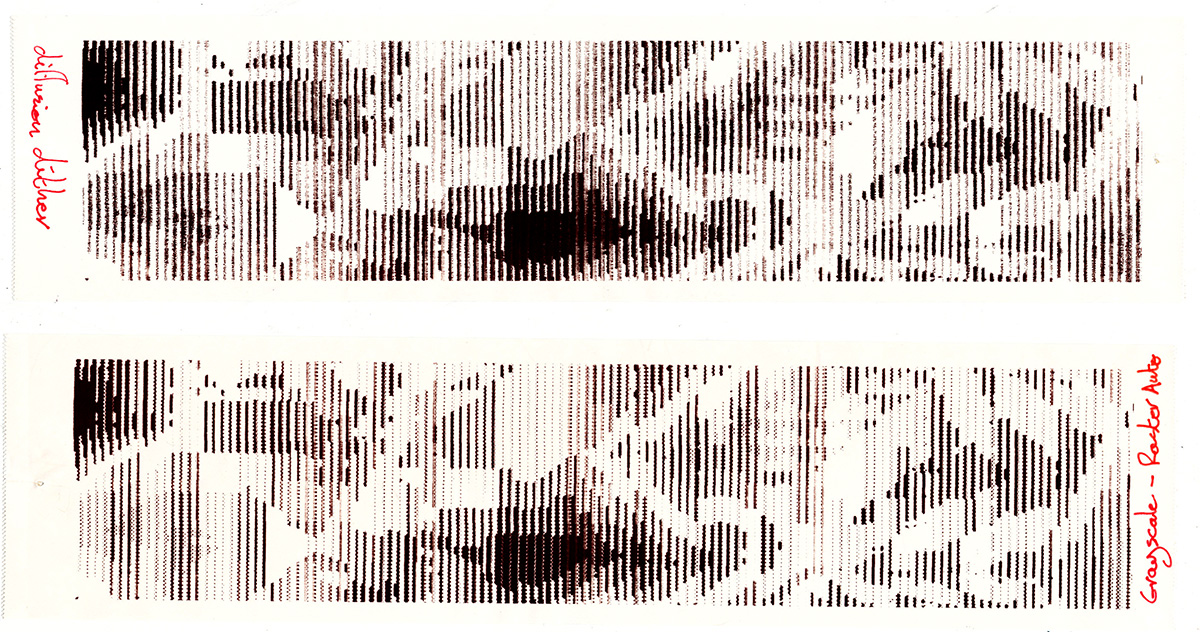
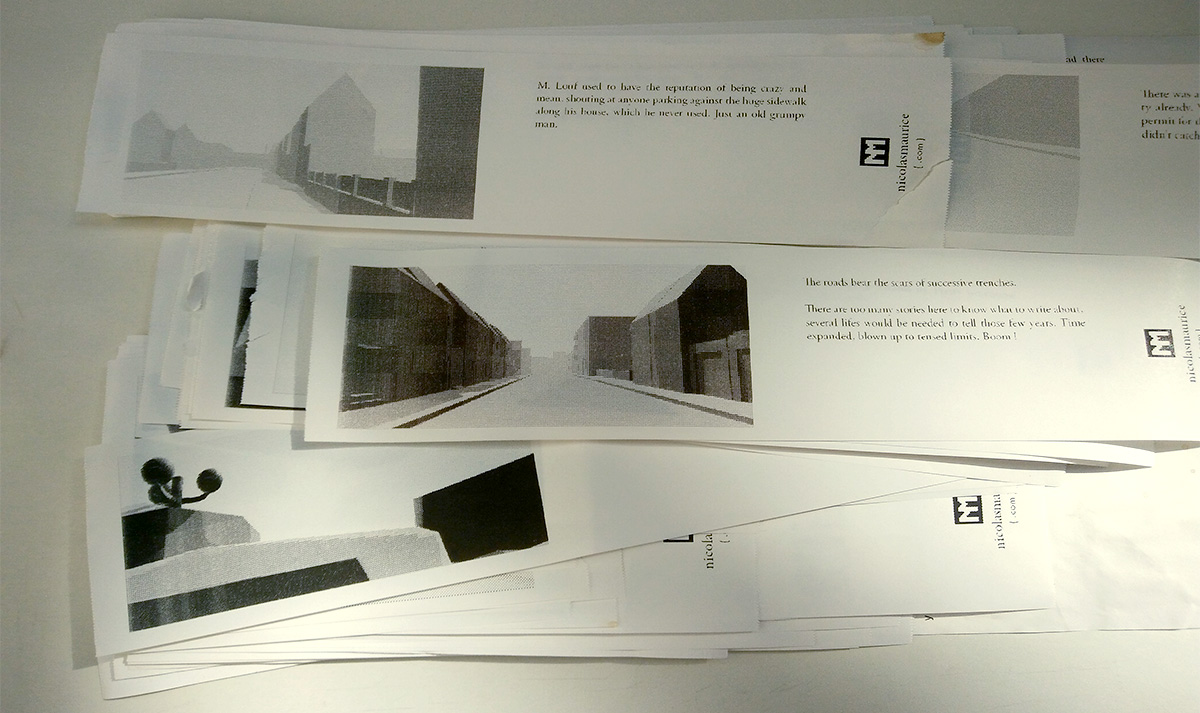
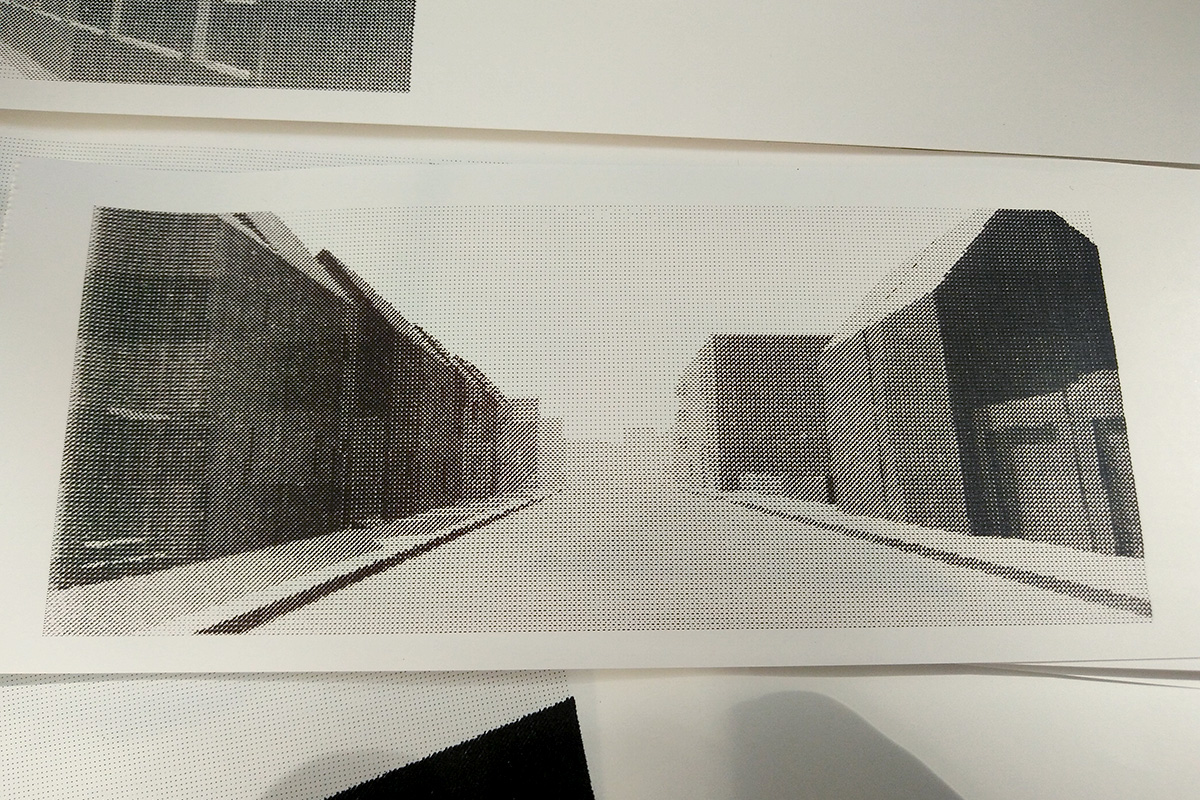
I started the building process of the 3D world using Goo Create, an online tool for making web based interactive 3D games. Unfortunately it turned out to be too difficult to use in this context, this tool being quite young and my coding skills being limited.
I therefore turned to a more established game engine called Unity, which has proven to be a strong tool with a very helpful online community. I was able to transfer my 3D models to this software and start scripting the interactive aspect. For this, I quickly learned basics of C# language and wrote the lines of code I needed to achieve what I needed.

The first layer of interaction was quite basic, getting the “character” to walk around, look around, run, collide with buildings. Then comes the response to text-spaces containing the stories. This step was more complex and had to be tweaked until the last minute.
My very first idea was to have stories present in the space but not visible, unless one would print an image through the thermal printer. The text would then be added to the picture and the story revealed. But this was too intricate and way too easy to miss. The next idea was to display a hint as one walks into a story, such as a short title, then the spectator could decide to display the full text of the story by pressing a button. But after testing it in a feedback session, the manipulation seemed to be too complicated and the stories too easily missed. After more discussions, I decided to display the full text on the screen as long as one stayed inside a story-space, overlaying white text on the regular view. If printed, the text would then be detached from the image and both would appear side by side. This has been the solution put in practice during the spring exhibition.
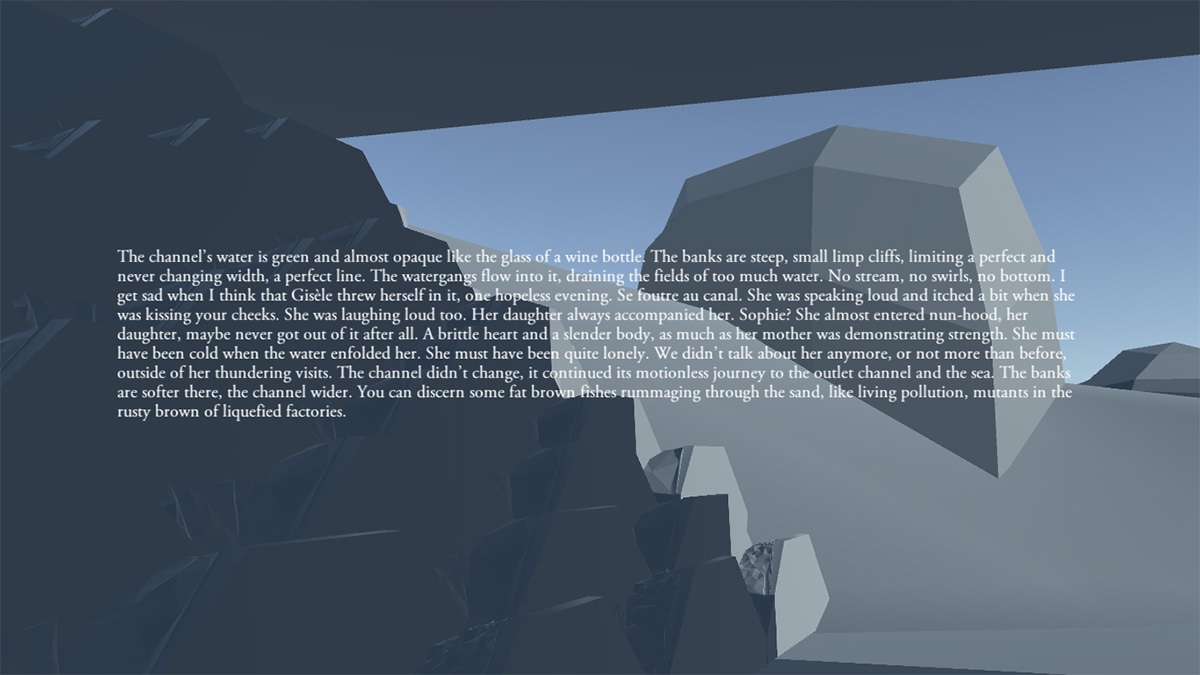
One other layer was a voice-over, reading the original text in French, which would trigger when walking in a story. I originally had no intention to add this voice to the piece, but during the process, it seemed to be add depth to the world, pulling it away from digital coldness into a more meaningful direction. Therefore I recorded all short stories and included them into the interaction. But still, I wanted the spectator to have the freedom to turn this voice off, without adding complexity to the controls. Therefore I decided to have the voice playing in a headphone set added to the installation. One could then decide to have it on or leave it.
I knew the soundscape would have an important role in the immersive dimension of the piece. For this, I worked with musician and composer Andy Yeo, who did a fantastic job in creating music which would fit this space, made of slow waves of digital sounds and melodies. He produced five tracks for me and I wrote a script to play them semi-randomly.
One last touch was to work on the light and the atmosphere of the space. All buildings being gray, they had to be somehow activated with subtly colored lights and shadows to bring them life, while the sky was made blue. My friend Thomas Oger helped me in scripting a day and night cycle for the light, with the sun rising and stretching the shadows, to a moonlit blue for the night. We also worked on a weather system, having random rainy days, according to the season. In practice, we have a full year cycle, with 28 days months and 4 seasons. These final touches really brought the space to life.
-
So, here are the layers of the final piece :
- – the 3D space
- – the text stories placed in space
- – the voice over reading each story
- – the printing possibility
- – the soundscape
- – the animated day cycle
- and, in parallel, the book, containing one possible exploration of this world.

I started prototyping the book with the first location I created, the space around the church. Following the idea of using default materials, I decided early on to use bare binder’s boards for covers as well as keeping the spine visible. This first test was xerox printed on “makulaturpapper” or “waste paper”, a very thin paper usually used for wrapping objects and reminiscent of newspaper.
I wanted the text to be both in French and English, allowing for a broader audience, but also reflecting my working process as I do write in French before translating the selected pieces into English. I wanted this translation to be my own and this space to be visible, trying to be honest and transparent, but also hinting at the place language takes in identity building, allowing me to redefine myself when I moved country and changed my everyday language. This aspect would deserve to be reflected upon in depth but I was happy to touch upon it with this detail.
The typefaces I used are Garamond for the French parts and Bembo for the English parts, in an interpretation of a classic layout. Again, I wanted to combine the default/traditional book practices with the memory of what a book looks like, referencing tradition but also bookmaking craftsmanship, the book being hand-bound and produced in 100 copies.
As I advanced into the process and accumulated writings and images, the book became thicker. I wanted the images to be in dialogue with the text, without being directly illustrative, leaving many pages white to allow for breathing and create a specific rhythm within the book.
Circumstances gave me access to a RISO printer, which I decided to use, both for economical reasons and for the specific raster it was giving me, linking the book to the receipt printer somehow, talking of pixels and digital in the analog object. After experimenting with different papers, I chose to use Xerox recycled paper, which has a slight gray color and quite low gsm, evoking pocket books and everyday publications. I used gray waxed linen thread to bind each book, rounding the spine before trimming the edges.



This process finished, I had a 224 pages self-published book.
ISBN : 978-91-983342-0-3 for more information.
Finally, in preparation for the spring exhibition, I built a piece of furniture to accommodate my computer, the printer and the book, as well as a bench. I also modified a game controller in order to reduce the buttons and controls to the ones I needed and avoid losing the users’ focus with non-functional controls as it had been the case in previous tests. Both furniture and the controller have been painted in a neutral gray color, suggesting the 3D models of the digital space and unifying the piece. A set of gray headphones was added. Music plays from the screen used for the installation, while the voice over plays in the headset.

references
Saint Augustine
(~400 AD), Confessions. (Book 11)
Proust, M.
(1927), Time regained (Chapter 3)
Bergson, H.
(1889), Time and Free Will: An Essay on the Immediate Data of Consciousness
(1896), Matter and Memory
Deleuze, G.
(1964), Proust and Signs
(1966), Bergsonism
Bertier, D.
(2004), Meditations on the real and the virtual - in French
Borradori, G.
(1999), Against a technological interpretation of virtuality, Hypersurface Architecture II, Architectural Design, Vol. 69: 9-10
Ffrench, P.
(2005), The Immanent Ethnography of Chris Marker, Reader of Proust, Film Studies, Issue 6
DeNicola, P.
(2009) Literature as Pure Mediality : Kafka and the Scene of Writing, part 1 and 2.
Rancière, J.
(2010) The emancipated spectator
contact
Music and sound-design by Andy Yeo
nicolasmaurice[at]gmail.com for more information.
.

